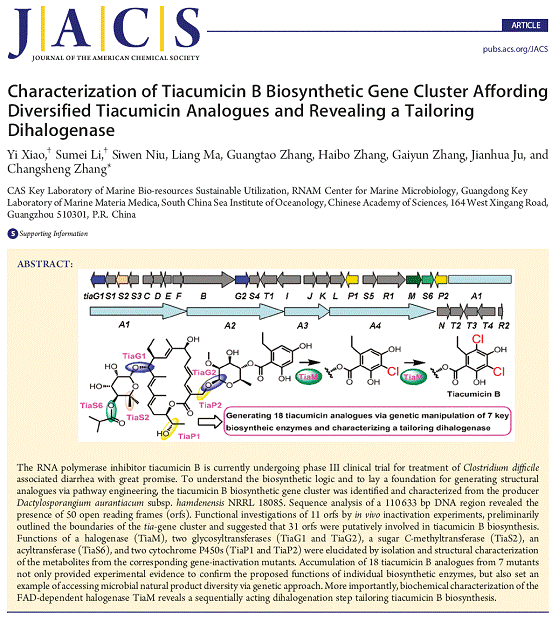Significant Progress on Biosynthetic Studies of Microbial Secondary Metabolites from the South China Sea Institute of Oceanology
The group of Biosynthesis and Engineering of Marine Microbial Natural Products, led by Prof. Changsheng Zhang in the South China Sea Institute of Oceanology, Chinese Academy of Sciences, made great progress on biosynthetic studies of microbial secondary metabolites. They identified and characterized the intact biosynthetic gene cluster of tiacumicin B, a promising anti-infectious drug candidate, and elucidated functions of key enzymes involved in tiacumicin B biosynthesis. These findings have been recently published on line in the Journal of the American Chemical Society (http://pubs.acs.org/doi/abs/10.1021/ja109445q,IF2009 = 8.58).
Tiacumicin B, produced by Dactylosporangium aurantiacum subsp. hamdenensis NRRL 18085, is an RNA polymerase inhibitor and is active against various Gram-positive pathogenic bacteria, especially diarrhea-associated Clostridium difficile. Tiacumicin B is currently undergoing phase III clinical trial for treatment of C. difficile infections (CDI) and is shown to be statistically superior to vancomycin, the only FDA-approved drug for CDI, in better global cure rates and fewer relapses. To understand the biosynthetic logic and to lay a foundation for generating structural analogues via pathway engineering, Zhang group has cloned and sequenced a 110633 bp DNA region from the producer, revealing the presence of 50 open reading frames (orfs). After making the producer strain D. aurantiacum NRRL 18085 amenable to genetic manipulations, systematic in vivo gene inactivation experiments were carried out to preliminarily outline the boundaries of the tia-gene cluster, suggesting that 31 orfs were putatively involved in tiacumicin B biosynthesis. With isolation and structural elucidation of 18 novel biosynthetic intermediates from the corresponding gene-inactivation mutants, functions of a halogenase (TiaM), two glycosyltransferases (TiaG1 and TiaG2), a sugar C-methyltransferase (TiaS2), an acyltransferase (TiaS6), and two cytochrome P450s (TiaP1 and TiaP2) were unequivocally elucidated. More importantly, biochemical characterization of the FAD-dependent halogenase TiaM reveals a sequentially acting dihalogenation step tailoring tiacumicin B biosynthesis, representing the first example of a tailoring halogenase of prokaryotic origin. This work not only provided experimental evidence to confirm the proposed functions of individual biosynthetic enzymes, but also set an excellent example of accessing microbial natural product diversity via genetic approach and highlights the combinatorial power of pathway engineering.
This work was supported in part by grants from the National Science Foundation of China, funds of '100 Talents Project' and of Key Topics in Innovation Engineering from Chinese Academy of Sciences, and funds of the National Basic Research Program of China (973 project). Drs. Yi Xiao and Sumei Li are the co-first authors of the JACS paper, with important contributions from Siwen Niu, Liang Ma, Drs. Guangtao Zhang, Haibo Zhang, Gaiyun Zhang and Prof. Jianhua Ju. Prof. Zhang is the corresponding author.